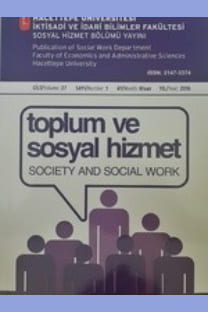LOGOTERAPİ: TEMEL BİLEŞENLERİ VE TERAPİ TEKNİKLERİ
Logoterapi, boyutsal ontoloji, anlam üçlüsü, varoluşsal boşluk, uygulama teknikleri, sosyal hizmet
Logotherapy: Basic Components and TherapyTechniques
Logo therapy dimensional ontology, the meaning triad, existential vacuum, therapy techniques,
___
- Andreasen, A. S. (t.y.). Logotherapy and spirituality: A course in Viktor Frankl‟sLogotherapy.ElektronikDosya.Erişimtarihi: 15.08.2016, https://www.yumpu.com/en/document/view/36912999/logotherapy-and-spirituality.
- Batthyany, A. (t.y.). What is logotherapyandexistentialanalysis? Erişimtarihi: 18.08.2016, http://www.viktorfrankl.org/e/logotherapy.html.
- Frankl, V. E. (1967). Psychotherapy and existentialism: Selected papers on logotherapy. New York: Clarion.
- Frankl, V. E. (1969). The will to meaning: foundations and applications of logotherapy. New York:World Publishing Co.
- Frankl, V. E. (2004). On the theory and therapy of mental disorders: an introduction to logotherapy and existential analysis (James M. Dubois, Trans.). New York: Brunner-Routledge.
- Frankl, V. E. (2007). Duyulmayan anlam çığlığı: Psikoterapi ve hümanizm.(4. Basım) (Selçuk Budak, Çev.) İstanbul: Öteki Yayınevi.
- Frankl, V. E. (2009). İnsanın anlam arayışı. (2. Baskı) (Selçuk Budak, Çev.) İstanbul: Okuyan Us Yayınları.
- Frankl, V. E. (2010). The feeling of meaninglessness: A challenge to psychotherapy and philosophy (Alexander Batthyany, Ed.). Milwaukee: Marquette University Press.
- Frankl, V. E. (2014). The will to meaning: Foundations and applications of logotherapy.(Paperback edition). USA: Meridian.
- Guttmann, D. (1996). Logotherapyforthehelpingprofessional: Meaningfulsocialwork. New York, NY, US: Springer Publishing Co.
- Guttmann, D. (2001). A Logotherapeuticapproachtothequestformeaningfuloldage, Jouranl of SocialThought, 20, 3-4: 117-128.
- Guttmann, D. (2008). Finding meaning in life, at midlife and beyond: Wisdom and spirit from logotherapy. Westport: Praeger Publishers
- Halling, S. veNill, J. D. (1995).A brief history of existential-phenomenological psychiatry and psychotherapy.Journal of Phenomenological Psychology, 26, 1-45.
- Ishiyama, F. I. veWestwood, M. J. (1992). Enhancingclient-validatingcommunication: Helpingdiscouragedclients in cross-cultureladjustment. Journal of MulticulturalCounsellingand Development, 20, 50- 63.
- Ivey, A. E.,Ivey, M. B. veSimek-Morgan, L. (1993).Counselingandpsychotherapy: A multiculturalperspective. Boston: Allynand Bacon.
- Jim, H. S.,Purnell, J. Q., Richardson, A. A., Golden-Kreutz, D. ve Andersen, B. L. (2006). Measuringmeaning in life followingcancer, Journal of Quality of Life Research, 15: 1355–1371.
- Lewis, M. H. (2011). “Defiant power: An overview of Viktor Frankl's Logotherapy and existential analysis”. Dissertation of Doctoral.Erişimtarihi: 15.08.2016, http://www.marshallhlewis.net/papers/Logotherapy_Overview.pdf.
- Lukas, E. (2000). Logotherapy: Textbook. Toronto: Liberty Press.
- May, R. veYalom, I. (1989). Existentialpsychotherapy. In R. J. Corsiniand W. Danny (eds), CurrentPsychotherapies. Itasca, IL: Peacock.
- Miceli, C. (2011). “Fromthe here andnow” tothe “nowwhat”: An introductiontologotherapy. Erişimtarihi: 18.08.2016, http://www.nacsw.org/Publications/Proceedings2011/MiceliCFromtheHereE.pdf.
- Pinquart, M.,Silbereisen, R. K. ve Fröhlich, C. (2009). Life goalsandpurpose in life in cancerpatients, Journal of Supportive in CareCancer, 17: 253–259.
- Ras, J. M. (2000). “An Evaluation of the logotherapeutic techniques of Viktor Frankl.”Dissertation of Masters of Arts in the Department of Psychology.University of Zululand.
- Sinnott, J. D. (2009). Complexthoughtandconstruction of the self in theface of aginganddeath, Journal of Adult Development,16: 155–165.
- Spiegelberg, H. (1972). Phenomenology in psychology and psychiatry. Evanston: Northwestern University Press.
- The International Association of Schools of Social Work (2014).Global definition of social work.Erişimtarihi: 11.03.2017, https://www.iassw-aiets.org/global-definition-of-social-work-review-of-the-global-definition/
- The International Federation of Social Workers (2014).Global definition of social work.Erişimtarihi: 11.03.2017, http://ifsw.org/policies/definition-of-social-work/
- Thompson, N. (2013). Kuramveuygulamalardasosyalhizmetianlamak.(1. Baskı) (ÖzlemCankurtaranÖntaş- BurcuHatipoğluEren, Çev. Ed.) Ankara: DipnotYayınları.
- Tillich, P. (1952). Thecouragebo be.New Haven: Yale UniversityPress.
- ViktorFrankl'sLogotherapy (t.y.). Logotherapeutictechniquesandtheirspiritualsource. Erişimtarihi: 18.08.2016, https://meaningtherapy.wordpress.com/2010/06/22/logotherapeutic-techniques-and-their-spiritual-source/.
- Wong, P. T. P. (1993). Effectivemanagement of life stress: Theresource-congruence model. Journal of StressMedicine, 9, 51–60.
- Wong, P. T. P. (2011). Meaning- centeredcounseling. Erişimtarihi: 18.08.2016, http://www.drpaulwong.com/wp-content/uploads/2013/09/Meaning-centered-counselling-chapter-19-1st-Ed_references-updated-Jan13-2011.pdf.
- Wong, P. T. P. (2012). Thehumanquestformeaning: Theories, researchandapplications. (Second Edition). NY: Routledge.
- Yalom, I. (2001).Varoluşçu psikoterapi. (Zeliha İyidoğan Babayiğit, Çev.) İstanbul: Kabalcı Yayınları.
- ISSN: 2147-3374
- Yayın Aralığı: 4
- Başlangıç: 2000
- Yayıncı: Hacettepe Üniversitesi İktisadi ve İdari Bilimler Fakültesi
LOGOTERAPİ: TEMEL BİLEŞENLERİ VE TERAPİ TEKNİKLERİ
TÜRKİYE’DE SOSYAL HİZMET EĞİTİMİNDE NELER OLUYOR?
Kamil ALPTEKİN, Selami TOPUZ, Oğuzhan ZENGİN
SUPERVISED PARENT- CHILD(REN) VISITATION PROGRAMS
Melis Sedef KAHRAMAN, Kelley M. BECKETT, Hüseyin BATMAN
Cemre BOLGÜN, Fatih ŞAHİN, Hakan BAYDUR
Denetimli Ebeveyn-Çocuk Görüşmesi Programları
